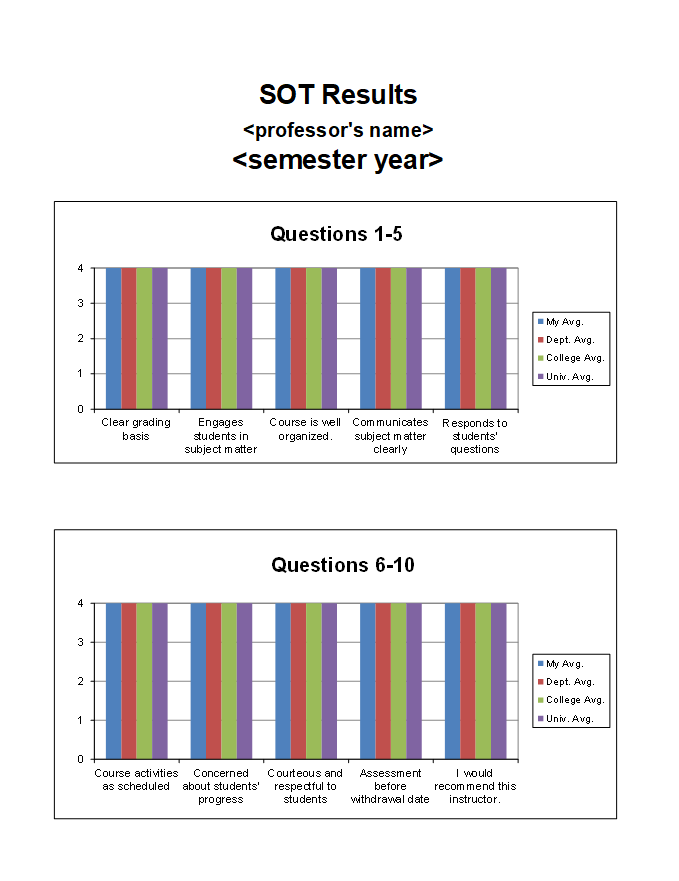The Professional Portfolio
Portfolio Fair
Are you beginning the process of your 3rd Year Review or Tenure and Promotion? The Center hosts an annual Portfolio Fair each October to assist you with this process. Sample portfolios are presented, and experienced faculty are present to answer your questions and discuss issues related to teaching, research and service. The fair is open to all faculty and will be announced via your Southeastern email.
Signature Pages
General Information
Use of Graphics
Graphs comparing your SOT scores with your department, college and university, along with your Grade Distributions are required.
The averages for your department and college, as well as the university, are provided by the Office of Institutional Research.
Please contact a team member at the Center if you need assistance with this process.
Materials
Traditionally, a 3", 3 ring binder has been used for the Professional Portfolio. However, the Center now provides faculty with an electronic portfolio option.
The information listed below (I-VII) is required by the Faculty Handbook (see Part III, Section H, pp. 7-8). The additional information (VIII-XI) is suggested for the portfolio.
Contents of the Professional Portfolio
I. Summary: Evaluation for Tenure form and/or Summary: Evaluation for Promotion form
Decisions by the Board of Supervisors to grant tenure and promote faculty in rank are separate actions. As a result, an application for tenure and/or promotion should be accompanied by the appropriate form(s), i.e., Summary: Evaluation for Tenure form and/or Summary: Evaluation for Promotion form. Assistant professors applying for tenure must also apply for promotion to associate professor. Accordingly, one application may be submitted. However, both Summary of Evaluation forms must accompany the application.
II. Narrative Summary
The narrative summary should not exceed five pages. Make sure you clearly state and justify the level of achievement you are claiming--- excellence, distinction, or adequacy relative to approved departmental guidelines---in the categories of Teaching/Job Effectiveness, Professional Activity, and Service. Your narrative summary should highlight the importance/significance of all work.
III. Curriculum Vitae
The curriculum vitae should be current, complete and outline the scope of ALL work.
IV. Annual Evaluations
V. Summary of Activities
The summary of activities should address each category of evaluation for each year.
VI.Course Syllabi, Examinations, and Grade Distributions
Bar graphs are a nice way to summarize your grade distributions. Any spreadsheet will do this, but the Center provides you with a template. Contact us (Center@southeastern.edu or ext 5791) if you need assistance.
Grade distributions should be on file with your Department Head. If not, you may request these from the Dean of your college or the Office of Institutional Research and Assessment.
VII. SOTs
You must include original printouts and a graphic representation of your results. This link provides a template for you to use:
Contact The Center for Faculty Excellence (CFE) if you need assistance, ext. 5791.
VIII."Best" or Representative works of Teaching/Job Effectiveness, Research and Service
Choose examples that support your accomplishments in each of these areas. You do not have to show all of your work, just one to three examples. An introduction to this section should provide a rationale for choosing these documents explaining their value, significance, or ability to represent "typical" examples of other efforts that could have been selected. Describe the impact your work has had on your students, colleagues, profession, etc.
IX. Supporting Information
You may include any other information which you feel would further support your case (e.g., annual self evaluations, letters of support, copies or excerpts from your publications). If you choose to include "comment" sections of the SOT form, only originals should be included.
Sample Professional Portfolio
(Example)
NARRATIVE SUMMARY
(As per the T&P Guidelines, here you will enter a concise narrative summary presenting the basis for requesting consideration for tenure or promotion, not to exceed five pages. You should clearly state and justify the level of achievement (excellence, distinction, and adequacy relative to approved departmental guidelines) on which level you believe the categories of Teaching/Job Effectiveness4, Professional Activity, and Service should be judged.)
TEACHING/JOB EFFECTIVENESS
Excellence in this category is supported by my continued research and implementation of innovative and effective teaching techniques, unsolicited peer correspondence, evaluations by department chairmen, and student opinion of teaching polls.
During my six years as a faculty member at Madison my course load has included College Algebra, Trigonometry, Business Calculus, Elementary Number Structure, Geometry for Teachers, Elementary Statistics, Mathematics of Finance, and Discrete Mathematics. This variety of courses encompasses a wide range of skills and techniques. I have tried to provide for the individual needs of my students by implementing a medley of pedagogical strategies, including cooperative grouping, class demonstrations, journal writing, group projects, manipulative activities, outside readings of professional journals, hands-on assessment, personal interviews, mathematics autobiographies, second-chance testing, and portfolio assessment. Because students can become so anxious and overwhelmed by mathematics, the use of innovative teaching techniques is essential.
In keeping with the growing use of technology, I have increased the use of technology in my classes. The use of the computer programs such as Geometer's Sketchpad and LOGO provide dynamic interaction for my geometry classes. TI-Explorer calculators are used to introduce arithmetic concepts in Elementary Number Structure. Various hand-held calculators, as well as computer programs, are used in Elementary Statistics and Mathematics of Finance. Along with a colleague, I have designed a college algebra course that will promote concept development through the use of the TI-82 graphics calculator.
Throughout my years of teaching I have found that I am most successful when my students direct the learning. To encourage this I try to provide a classroom atmosphere in which there is a sense of community where "we're all in this together." I encourage questions, discussions, and free play. Many times I will give students a problem situation with little or no explanation and have them work toward a solution. Watching students take responsibility for their own learning is not only profound but also rejuvenating. Having them share their strategies and revealing my own helps to instill the idea that I am a co-learner in the classroom and not the sole possessor of knowledge. The following remarks are taken from the self-evaluation of a geometry student. These remarks best depict what I try to accomplish in my teaching of mathematics:
I think I have learned more useful information in this one class than I have in all my college years. You have made the information/material really make sense. The way you've done this is by making me figure things out on my own. I can finally see the reasons "Why" we do certain things in mathematics (I think everyone should take this class.). I feel proud, like I've really accomplished something!Excellence in teaching only occurs when we give our students the opportunity to take ownership of their learning.
While the rewards of teaching are usually measured by a spark in the eye, a nod of the head, or a smile on the face, my efforts received more tangible recognition this summer. In May of 1995, the Board of Regents asked universities to nominate "Innovative and Effective Teachers" in mathematics, science, and engineering. In June, 1995 I was pleased to discover that I had been nominated by the Madison Department of Engineering as an Innovative and Effective Teacher of Mathematics. This unsolicited recognition by a department other my own is most gratifying.
My effectiveness as a teacher is further supported by the excellent ratings I am given on evaluations by both my students and my department chair. In each of my 12 semesters at Madison my average on the student opinion of teaching (SOTs) has been considerably higher than the average of my department, my college, and the university. While many of the questions on the SOTs receive high ratings, the question which always seems to have the highest score is that concerning "Shows respect for students." This clearly documents my personal concern and dedication to the student's welfare.
Since coming to Madison in 1992, my teaching has been reviewed by four different colleagues and three different department chairs. In the evaluation of my teaching effectiveness I have received excellent ratings from all seven individuals (ranging from 8.5 to 10 on a 10 point scale). A rating of this caliber from such a variety of sources further supports my contention that I have achieved excellence in teaching effectiveness.
To be a successful teacher is to be constantly evaluating, updating, and improving materials, techniques, and yourself to provide the best possible learning experience for your students. My continued struggle to improve my teaching, my willingness to serve my students, and my outstanding evaluations from my chairmen and my students indicate that I have achieved excellence in the area of teaching effectiveness.
PROFESSIONAL ACTIVITY
Distinction in professional activity is supported in the areas of research and publication, paper presentations, grant proposals, and attendance at conferences and seminars to promote professional growth in both the areas of teaching and job effectiveness.
In addition to my teaching duties, I have been very active professionally. Since coming to Madison I have submitted ten articles for publication in refereed journals and refereed eight manuscripts for publication. Seven of the articles have been published, two are being revised for further consideration, and one has been returned.
My professional endeavors have also included attending and presenting papers in over fifteen state, regional, and national conferences. The success of these efforts are further recognized by invitations to speak at four national conferences of the National Council of Teachers of Mathematics (NCTM), one national conference of the North American Chapter of the International Group for the Psychology of Mathematics Education (PME-NA), two national conferences of the Mathematical Association of America, and two national conferences for Teachers Teaching with Technology (T3). In addition, I represented the mathematics department of Madison at the national AAHE conference on mathematics and history reform in Washington, D.C. in November, 1994.
In addition to attending many conferences on mathematics and teaching, I represented Madison as an invited participant in one state and one national institute during the summer of 1995. The national institute on mathematical content and pedagogy was held at the University of Georgia and involved a competitive selection of 28 participants from applicants throughout the United States. The only other California university represented at this institute was California Tech. The state institute on mathematics for preservice teachers was held at the University of San Diego. Only three of the participants at this institute were from universities outside of the greater San Diego area.
Since the attainment of external funds has been emphasized by the College of Arts and Sciences, I have tried to make a contribution. I have been involved in the writing of four major grants: A Title V grant, "Teacher Enhancement for Academics in Mathematics and Engineering"; an CEQSF grant for "Curriculum Revision in Mathematics" (CRIM); an NSF grant "Leadership training for Teachers of Middle School Science and Mathematics: A Pilot Program"; and a Hugh s grant "Eastern Mathematics and Engineering Curriculum Development Project." The Hugh s grant was awarded $125,000 and will begin in January, 1998.
I have sought additional funds to support my students and my department from teaching enhancement grants. Through numerous grants I have managed to build a library of mathematics manipulatives and calculators that can be used in and out of the classroom. These manipulatives not only enhance classroom teaching but are also available for students to check out when they do practice teaching.
I continue to maintain contact with professional organizations. Current memberships include the National Council of Teachers of Mathematics (NCTM), the Mathematical Association of America (MAA), California Association of Teachers of Mathematics (CATM), the Special Interest Group for Research in Mathematics Education (SIG/RME), Pi Mu Epsilon, and Phi Delta Kappa.
The activities outlined above represent a diverse collection of professional contributions. While these activities have been in addition to the demands of a full-time teaching load, I feel I have represented Madison with distinction.
SERVICE
I have also attained distinction in the area of service. In my six years at Madison, I have spent many extra hours in service to the University, the students, and the community. In addition to the numerous committees of my department, I have also devoted many hours to university committees. My membership in committee work at Madison is highlighted by my service on the Teacher Education Council, the Ad Hoc Advising Committee for Arts and Sciences, the Developmental Education Committee, the Committee for the Electronic Learning Lab, the Commencement Committee, and the Academic Honors Convocation Committee. The charge of each of these groups attests to the value of my contribution in the area of service to the University.
My service to the students of Madison is not limited to the classroom. I take my duties as an academic advisor very seriously. I serve as an advisor for students majoring in mathematics and I am also a volunteer advisor for students in the junior division. I maintain regular office hours and my door is always open to any student who needs to discuss academic or personal matters. At the request of my department chair, I wrote the advising policy for the mathematics department and now serve as the coordinator.
I provide additional service to our students by chairing my department's Student Activities committee and coordinating the national Mathematics Awareness Week which is celebrated each spring. Each of these provide a means for involving students in the beauty and joy of mathematics while lessening some of their anxieties. Some of our activities have included pizza parties, help-session parties, final exam study sessions, math trails, and problems for extra credit.
In regard to public relations with the community I have tried to reach our future as well as our former students. I have held workshops for local elementary and secondary teachers. High school students from surrounding areas have been invited to take part in Math Awareness Activities. I have administered and graded tests for the Literary Rally, interviewed scholarship candidates, and served as a judge for the mathematics division of the Regional Science Fair.
CONCLUSION
Teaching is a very demanding and challenging profession, but the rewards of success are unmeasurable. I have devoted the past six years of my professional life to Madison because I believe and support the mission of this university. My work has been competent, diligent, enthusiastic, and professional.
According to the faculty handbook (2000, III: 20) tenure should only be granted to those faculty members who demonstrate the ability and potential of advancing the mission of the University. While teaching at Madison, more than 2,000 students have successfully completed a mathematics course under my direction. In the College Algebra course, which has an overall withdrawal rate of over 50%, my average withdrawal rate in the 12 semesters that I have taught the course is 24.65%. I feel that I have served the mission well.
Promotion in rank should occur "as fast as possible" and is recognition of the faculty member's past achievement as well as his or her future potential for professional growth and the assumption of increasing responsibility (Faculty Handbook, 2000, III: 20). Since coming to Madison I have submitted ten articles for publication in refereed journals, refereed eight manuscripts for publication, received over $550,000 in external funds to enhance the teaching and learning of mathematics, assisted in writing and revising a student workbook and teacher's manual for College Algebra and Elementary Statistics, and been invited to speak at nine national conferences. I feel my potential for professional growth is obvious.
In view of the efforts outlined in my narrative and supported by the documents that follow, I have fulfilled the requirements set forth by the guidelines for promotion and tenure. I have achieved excellence in teaching and distinction in professional activity and service. On this basis I am requesting tenure and promotion to associate professor of mathematics.
The Bar Graph

Executive Summaries
(The following information is contributed by Dr. Richard Louth, former Professor of English.)
Executive Summaries in Professional Portfolios
-
Each major section of the portfolio---teaching, professional activity, and service---is prefaced by an executive summary. The executive summary is a one-page overview of a section which condenses and explains the value of the section's contents for an audience of evaluators.
-
While it is most important that the contents of a section be carefully selected, it is even more important that they be carefully explained through the executive summary. The executive summary serves primarily as an introduction to the reader, describing a section's contents and clarifying why these particular contents were chosen.
-
Still, the executive summary should be considered not only descriptive information but also persuasive. It should help guide readers' evaluation of a section's contents and offer proof of how those contents demonstrate claims of adequacy, distinction, or excellence. A strong executive summary should allow a reader to scan and evaluate the contents of the section quickly yet with confidence.
Hints on Writing the Executive Summary (ES)
View the ES as a persuasive essay:
-
State your claim as a thesis (excellence, distinction, adequacy).
-
Think in terms of introduction, body paragraphs, & conclusion.
-
In the body, prove how specific contents support your claim.
-
Use the whole space provided.
Begin with an Introduction:
-
Make your claim (excellence, distinction, adequacy).
-
Describe the section's contents briefly.
-
Provide context for the reader:
*Why were these particular contents chosen above others?
--Example: a particularly innovative teaching technique.
--Example: an article from a highly competitive journal.
--Example: an extraordinary time-consuming service.
*What other valuable contents had to be omitted due to space?
*What, in particular, should readers notice?
--State the organization and purpose of the following paragraphs.
Prove Your Point in the Body:
-
Visualize the ES as a road map to the section's contents.
-
Devote a paragraph to each item of the contents.
-
Summarize each item of contents in one clear sentence.
-
Devote each paragraph to proving one important thing about contents.
Be Brief in the Conclusion:
-
No need to summarize such a short piece.
-
Be careful not to change tone here. Remain objective.
-
You may want to restate your claim.
Final Advice:
-
Revise and proofread so that the ES is concise and easy to read.
-
Allow a close colleague to view your ES and make suggestions.
-
Read all three of your ES together. Do they provide a coherent picture?
Tenure/Promotion Documentation Guidelines
A faculty committee generated the following guidelines for your use in preparing the portfolio.
Tenure and promotion decisions are very serious aspects of a faculty member's progression through the professional ranks of higher education. This progression is inaugurated during the initial hiring process for a tenure track position and assumes the following:
-
The candidate is selected who will best fit the needs of the position being searched.
-
The qualifications of the candidate support the expectation of success in tenure and promotion progression.
-
The candidate is expected to contribute in moving the program to a higher level. The University is responsible for providing appropriate support for this improvement.
Traditionally, expectations for documenting the tenure and promotion process have been interpreted to suggest that every entry on the curriculum vitae should be supported with appropriate verification of that entry. What has resulted is a "culture of quantity first." Faculty have often felt they must submit "bowes" or "tubs" of evidence verifying their productivity, or they will be found, in some way, deficient regarding the documentation requirement. The amount of time and effort devoted to the preparation and review of these materials has become a concern of both faculty and all levels of administration. The administration has determined that the following approach will set the standard for expectations in this regard.
Department Heads will establish a program of thorough review in their approach to monitoring faculty productivity, and, as a result, will be responsible for annual review of accomplishments (including appropriate documentation). Intended results of this effort are to:
-
Better support tenure track faculty as they head toward the interim, three-year review and subsequent tenure and promotion candidacy by providing more immediate feedback.
-
Enable faculty to re-direct the time and energy they spend away from assembling their materials toward efforts that will improve their chances in achieving their tenure/promotion goals.
-
Limit the amount of review materials Peer Evaluation Committees and Department Heads/Deans are required to evaluate at tenure/promotion review time.
Faculty will be restricted to one, three-inch binder provided to them by the administration for the purpose of submitting a portfolio that would include the following:
-
Those required components listed on p. III: 28 in the Faculty Handbook (e.g., narrative, curriculum vitae, evaluation summaries, etc.).
-
One to three samples of the faculty member's "best work" in each of the three required areas of productivity (Teaching/Job Effectiveness---Professional Activity---Service).
-
A one-sheet rationale (in each of the three areas) for choosing these documents explaining their value, significance, or ability to represent "typical" examples of other efforts that could have been selected.
-
Any other information which the candidate believes would further support the application (providing it is contained within the physical limits of the three-inch binder).
The curriculum vitae will outline the scope of all work. The narrative summary will highlight the importance/significance of all work. The samples will provide the committee with a "best work" documentation. The availability of additional documentation will satisfy the need for any further evidence of accomplishments. The portfolio as a whole should be a concise picture of the faculty member and his/her accomplishments during the review period.
This approach to the documentation of the tenure/promotion process, along with annual in-service opportunities, should provide for the following:
-
Faculty will have some definitive guidelines for expectations in documenting their productivity. No longer will faculty be left guessing whether they have included enough documentation or if they have provided the right types of documentation.
-
A model for faculty to follow will soon be on file in the Dean's Office of each college. The Center for Faculty Excellence will provide inservice/workshops for additional instruction in preparing the portfolio.
-
Faculty will still be responsible for providing additional documentation to the review committee/Department Head/Dean, if requested. These three groups/individuals will not be expected to review boxes and tubs of materials as standard procedure, but may require copies that would document any entry or assertion made in the portfolio.
-
There will be a greater focus on quality and significance of the submitted work, not potentially obscured by the quantity of documentation submitted.
-
As the candidate's materials proceed up the ladder of review (Department Heads, Deans, and Provost), there can be a greater focus on fidelity to procedural concerns and less emphasis on judging individual content of the portfolio.






